Note: This website was automatically translated, so some terms or nuances may not be completely accurate.
Gunze Museum: Conveying the Realization of Coexistence and Co-prosperity and Sustainable Management

While women's empowerment and sustainability are hot topics today, over a century ago, a company was already working to elevate women's status and develop the local community. That company is Gunze, known as a manufacturer of underwear and stockings. This article examines the "GUNZE Museum," located at the company's founding site, which conveys GUNZE's journey and future vision. Through improving sericulture technology and education, GUNZE protected impoverished sericulture farmers in the region, particularly women, and pursued sustainable management through "coexistence and mutual prosperity" and partnerships with all business partners.
Reporting and Text: Akemi Sakurai (PR Consulting Dentsu Inc.)
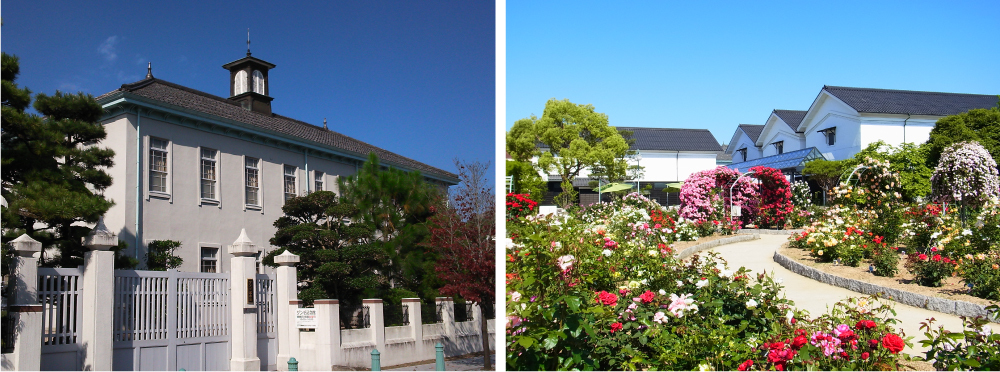
Gunze Museum Garden in Close Collaboration with Ayabe City
Located in northern Kyoto, Ayabe City is a rural town of over 30,000 residents blessed by the Yura River system. The tourist hub "Ayabe Gunze Square," a 10-minute walk from JR Ayabe Station, opened in 2014. Covering 8,257 square meters, it houses the "Ayabe Rose Garden (operated by the Ayabe Rose Society)," the "Ayabe Specialty Products Hall (managed and operated by the Ayabe Chamber of Commerce and Industry)," and the "Gunze Museum Garden," jointly operated by Gunze and the Ayabe Chamber of Commerce and Industry.
Although Gunze's headquarters functions are based in Osaka, the Gunze Museum Garden was established in 1996 as a 100th-anniversary commemorative project. This initiative aimed to utilize the historical buildings preserved in the company's founding location and contribute to regional revitalization. Following two renovations for the 110th and 120th anniversaries, the opening of "Ayabe Gunze Square," and the hosting of seasonal events, annual visitor numbers increased to 42,000 before the COVID-19 pandemic. It is used for training new employees and executives, and is visited not only by business partners and shareholders, but also by elementary, junior high, and high school students from over a dozen local schools annually (12 schools in 2021). In-person guided tours are also provided upon request.
The Museum Garden consists of four storehouses: the "Past and Present Storehouse," which utilizes a Taisho-era silk cocoon storage building to showcase Gunze's history; the three aligned exhibition storehouses—"Foundation Storehouse," "Modern Storehouse," and "Future Storehouse"; the "Gathering Storehouse," usable for meetings; and the "Dōkōan" (rest house), the former company housing for the founding couple and employees. Additionally, although open only on Fridays, the adjacent "GUNZE Memorial Hall" – a Western-style building constructed in 1917 (Taisho 6) as the company headquarters – stands across from the company housing. Visiting all these sites together reveals the essence of GUNZE's founding principles.
The entire area is designated as a Modern Industrial Heritage Site by the Ministry of Economy, Trade and Industry. As Gunze strives for environmental conservation, Ayabe City has buried overhead power lines and improved sidewalks in the surrounding streets, aiming for registration as a "Kyoto Prefecture Landscape Asset." It has become an ideal filming location for movies and dramas set in the Meiji and Taisho periods. Films like "The Man Called Pirate" and dramas such as "LEADERS" (based on Toyota Motor Corporation founder Kiichiro Toyoda) and Kagoshima TV's 50th-anniversary program "Masana Maeda: The Man Entrusted by Ryoma" were filmed here. Now, the Gunze Museum Garden and Ayabe City share a dream: to have the life story of founder Hatano Tsurukichi and his wife Hana featured in an NHK morning television serial drama. They established the "NHK Morning Serial Drama Promotion Council" in 2015 and are focusing their efforts on attracting this project.
Key Concepts: Respect for Humanity, Production of Quality Goods, Coexistence and Mutual Prosperity with All
The key concept of the Gunze Museum is to convey Gunze's founding spirit—"Based on respect for humanity and the production of quality goods, we strive for coexistence and mutual prosperity with all stakeholders surrounding the company"—through its exhibits and materials. During our interview, Director Norihito Takao, who guided us through the facility, stated: "We want visitors to understand not just the history traced here, but also the Gunze we are today—a company advancing toward sustainable management that balances economic and social value, and toward realizing our 'Desired State' for 2030, as outlined in the SDGs."
The museum's exhibition halls and memorial displays clearly illustrate how the founding couple provided education to female employees, worked tirelessly to protect the interests of partner sericulture farmers, and how the company is currently engaged in developing sustainable products like environmentally friendly goods and medical products aimed at improving quality of life.

About Founder Tsurukichi Hatano
Gunsai Silk Manufacturing, founded in 1896 (Meiji 29), used the kanji characters for "Gunsai" until its name change in 1967 (Showa 42). This "Gunsai" signifies "the policy of the district" (referring to the former Ikaruga District). Founder Tsurukichi Hatano was born as the second son of the Hamuro family, a prominent village head family. At age 8, he became an adopted son of his mother's family, the Hatano family. Deeply moved by a lecture by Masanori Maeda—former Vice Minister of Agriculture and Commerce who formulated the Meiji government's industrial promotion policies—stating, "The urgent task of today is to establish national principles, prefectural principles, district principles, and village principles," Hatano established the company. This was driven by his firm conviction that "to develop the district, the silk industry must be fostered as a local industry" and his tireless, self-sacrificing efforts. It wasn't that he harbored ambitions to become a businessman. Having experienced a major setback in his youth, it is more accurate to say that during his years as a teacher in his twenties, witnessing firsthand the unjust treatment and impoverished lives of many students' families—silk farming households—spurred him to action to protect the interests of farmers.
Ten years before founding his company, Tsurukichi worked tirelessly to establish the Nika District Sericulture Association. He invited Masanao Maeda to give lectures, exposing local people to new ideas and striving to foster understanding. However, getting the farmers on board proved far from straightforward. Everyone kept their know-how within their own households, unwilling to act for the collective good. Ultimately, he concluded, "Perhaps I must do it myself," and resolved to establish the company with the support of his wealthy family. His key focus during establishment was making each silkworm farming household a "shareholder" with a small investment. The amount contributed wasn't crucial. Tsurukichi's aim was for each person to participate in company management and take ownership. He sought to create a virtuous cycle where silkworm farmers and the company mutually spurred each other on.
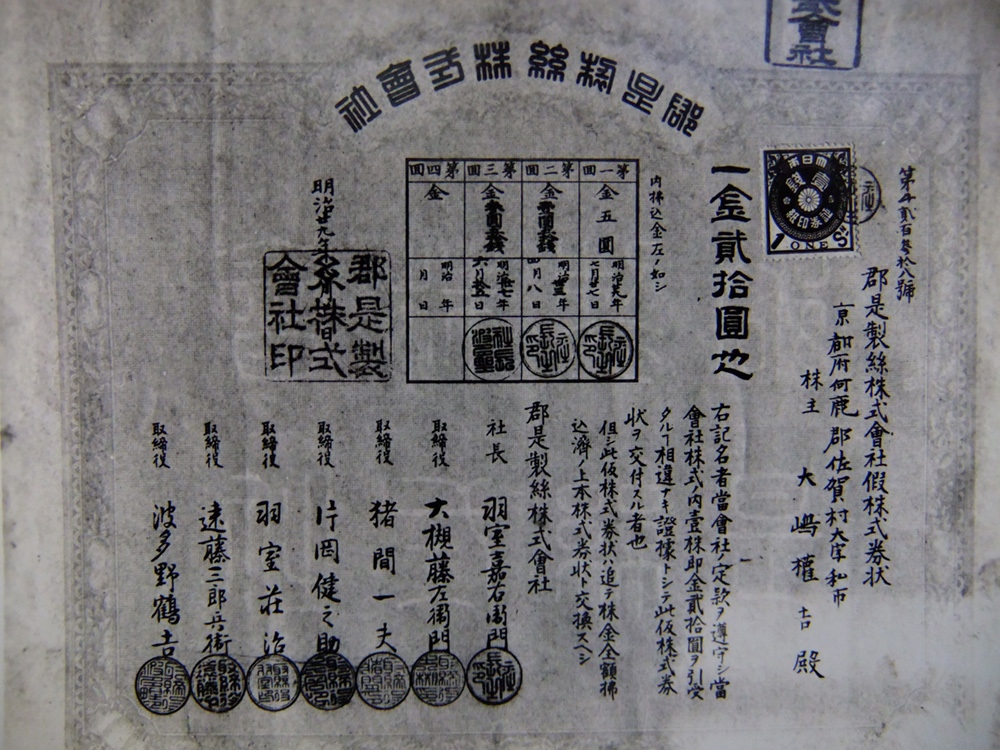
To produce high-quality thread
The name Ayabe originates from the Han people (Ayahito) who settled in the Hanbu district, skilled in twill weaving. The area was long known as a center for sericulture and textiles. However, at the 1885 National Exhibition (a product competition), it was branded with the dishonorable label of "the worst of the worst" (inferior products). Tsurukichi's challenge was to "produce silk thread of unmatched quality." The work of sericulture farmers involved cultivating mulberry leaves as silkworm feed, rearing the silkworms, and spinning silk thread from the cocoons. This required an incomparably greater amount of labor than ordinary farming, making it "farming they would rather avoid if possible."
Yet at the time, Japanese raw silk was a major export, earning about 60% of the country's foreign currency. Demand was ample. Silkworm farmers then suffered from unfair practices: middlemen unilaterally set prices, and raw silk became a speculative commodity, subjecting farmers to wild price swings. Tsurukichi moved to correct these unjust conditions. First, to stabilize the volatile raw silk prices, he established the "market price forward contract" (1901), which fixed transactions at the market rates on the 5th and 10th of each month, thereby stabilizing farm operations. Next, he introduced "fixed-quantity transactions" (1909). By signing purchase contracts with farmers guaranteeing advance buyouts based on quality grades, he built partnerships enabling farmers to make sound efforts toward quality improvement. He issued the directive, "Make buying a joy and selling a joy," aiming for sustainable corporate management and mutual social development through fostering good relationships with employees and partners.
A factory from the front, a school from the back
At one point, Tsurukichi heard from company executives that "farmers who produce good thread have harmonious families." He realized that to make good thread, it was crucial to foster good families, and before that, to cultivate good people. Tsurukichi was also known as a devout Christian, free from self-interest and dedicated to frugality. He lived alongside his employees in the company housing building called Dōkōan, sharing their daily lives.
This Dōkōan building was relocated and preserved within the Gunze Square grounds. It provided educational opportunities at night for female employees, known as "factory girls" who worked in the factory during the day, fostering their development, including their humanity. Gunze had an Education Department, headed by Shinmizu Kawai, a Christian and educator. In 1917 (Taisho 6), he established the "Gunsai Girls' School," known as the "Bride School." Female workers were presented with a dressing table after four years of service and a chest of drawers after six years, serving as wedding gifts. These initiatives were so significant that the factory was described as "a factory from the front, a school from the back."

The Founder's "Belief" That Overcame Countless Hardships
Tsurukichi's character, drive, and conviction repeatedly saved the company from crisis. The first instance involved employees voluntarily proposing wage cuts. The Gunze Memorial Hall displays petitions from workers who, when the company's performance deteriorated, directly appealed: "Please lower our salaries to protect the company." The second instance was the commitment by the major American textile company, Skinner & Co., to purchase all of Gunze's yarn. Owner William Skinner himself came to Japan to meet Tsurukichi, deepening their trust and expanding their business relationship. The "Memorial Hall" and "Founding Warehouse" display the raw silk trademark used for Skinner & Co.
The third turning point was the substantial unsecured loan from the main bank. Kuniji's main banks, Meiryo Bank and the Fukuchiyama Branch of Daihyakujusan Bank, collapsed during the financial panic. Zenjirō Yasuda, founder of Yasuda Bank, was asked by the government to rescue Kuniji. Suspecting that Daihyaku-jū-san Bank had extended unsecured loans to Gunji, Yasuda personally visited Tsurukichi. He asked a janitor, dressed in a kasuri kimono and sweeping the entrance, to connect him with Tsurukichi. Unbeknownst to him, this janitor was none other than Hatano Tsurukichi himself, simply in his everyday attire. Yasuda instantly recognized Tsurukichi's conviction and continued the loan. That trust remained unshaken throughout his life. When Kōji faced dire straits due to a massive crash in silk prices, Yasuda, on his deathbed, reportedly left behind the words: "If the worst happens, save Kōji."
Her Majesty the Empress Makes Her First Inspection of a Private Company
Just four years after founding the company, Gunze exhibited at the Paris Exposition Universelle and won a gold medal. Furthermore, its management philosophy of pursuing quality and its contributions to the community earned the recognition of the Imperial Family, including the Emperor and Empress, who were involved in sericulture. Consequently, in 1917 (Taisho 6), 21 years after its founding, Gunze became the first private company to receive an Imperial visit from the then-Empress (Empress Teimei). At that time, an Imperial visit by Her Majesty the Empress was a tremendous honor, naturally becoming a major event for the region. Roads were even improved for the procession of carriages. The second floor of the Gunze Memorial Hall preserves the original Japanese-style room where the Imperial Throne was placed and attendants waited. It displays items bestowed by the Imperial Household, including an incense burner depicting the life cycle of silkworms and historical photographs.

Transition to Apparel: From Raw Silk to Nylon and Knitwear Production
In 1934 (Showa 9), spurred by the production of full-fashioned socks, Gunze sought to transform into an apparel company. Facing soaring raw material costs, sluggish exports, and the rise of nylon, the company gradually scaled back its silk industry, shifting its focus to the production of knitted underwear and nylon stockings. In the "Modern Warehouse," mannequins wearing colored stockings and crossing their legs stand proudly like large flowers. Stockings are legwear that symbolize working women. This clearly shows how this company has consistently supported women since its founding.
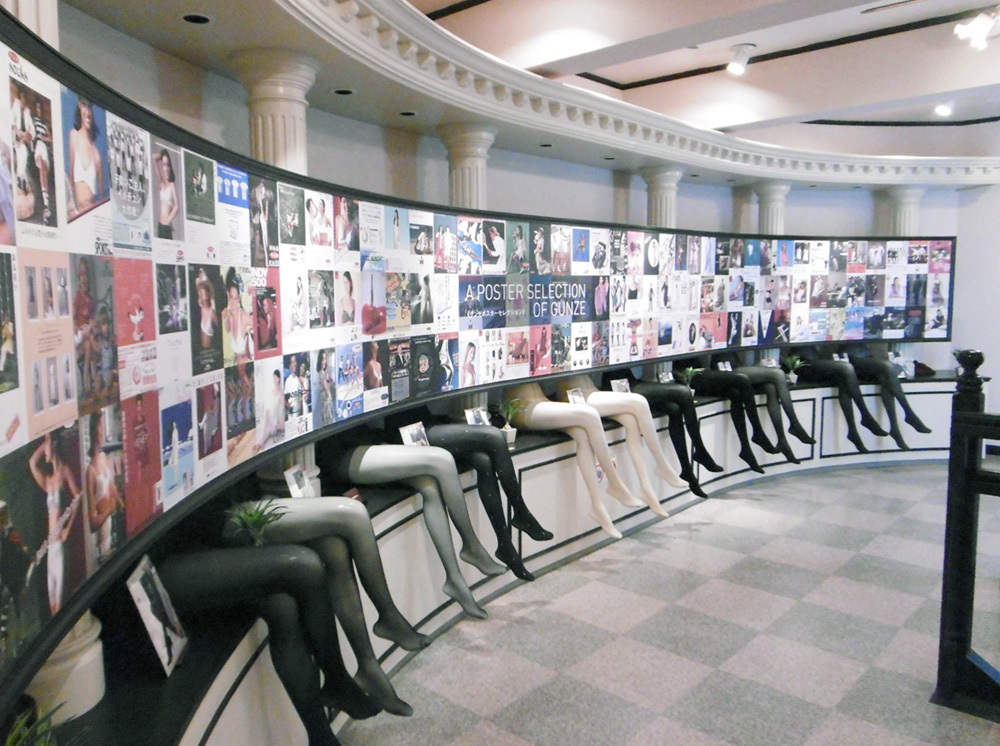
Expansion into Plastic and Medical Businesses
Looking at 2021 results, apparel sales accounted for 46% of total revenue, while functional solutions—including plastic film and medical fields—made up 45%. The company plans to reverse this ratio going forward. A major turning point for functional solutions was the launch of the plastics business in 1962. Recognizing the potential of plastic resins within the rapidly growing petrochemical industry, Gunze first began in-house production of packaging film for socks. Concurrently, research was conducted on functional films for various applications. Director Takao explains, "GUNZE has always had a culture of doing everything we can ourselves... Since we were already producing packaging in-house, we possessed the foundational technology for plastic film manufacturing." This bold pivot into plastics started small but quickly became the backbone supporting GUNZE. The "Modern Warehouse" displays packaging made from the company's own plastic films alongside products.
The "Future Hall" displays samples of outer packaging for frozen foods designed to be environmentally conscious and resistant to damage during transport, alongside medical products aimed at improving quality of life. The projection mapping that displays images of regenerative surgery for cuts or skin damage on the visitor's own palm, and the regenerative medicine experience corner, are popular attractions offering a simulated experience of cutting-edge medical technology.
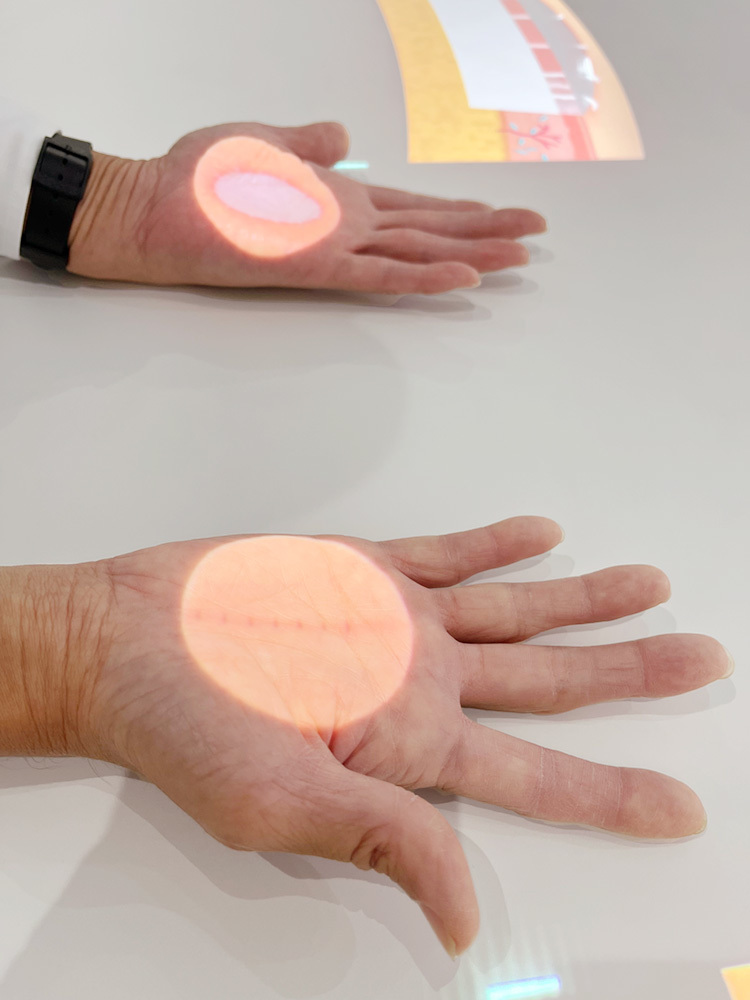
Toward Realizing a Co-Created Future Society
Tsurukichi left behind many words, displayed throughout the museum. Among them is the phrase, "Add the burden of 'for the sake of society'." He believed that focusing solely on company growth becomes a heavy burden; adding the idea that the company's growth also serves society brings balance and makes work easier. This phrase embodies the expectation for employees to carry the burden of "for the sake of society" alongside their work. Every year, the entrance ceremony for new Gunze employees nationwide is held in Ayabe, the company's founding place. The founder's vision is conveyed by the president to these new employees, who will shoulder Gunze's future, ensuring its legacy is passed on.
The Gunze Museum will continue to serve as a vital information hub, sharing Tsurukichi's life story—marked by overcoming numerous hardships—and his legacy of corporate activities "for the benefit of society" with a wider audience.
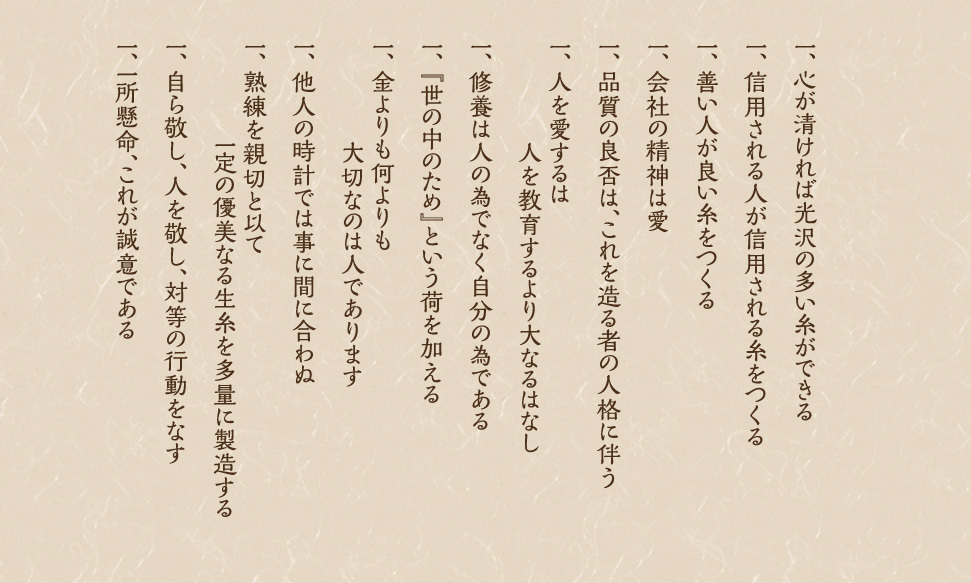
[Editor's Note] (From the Web Dentsu Inc. News Editorial Department)
When you think of Gunze, socks and underwear likely come to mind first. But this reminded me anew that there was a strong conviction about "thread" at its core. Thread may seem incredibly fragile, yet when spun together, it becomes something strong. It becomes something that protects human life. Isn't that where Gunze's spirit lies?
Carefully knitting together the finest, finest threads. It's a mind-numbing task. Yet, beyond it lies the certain promise of a warm, comfortable life. For that, Gunze continues its journey.
Modern people toss things away carelessly. If a sock gets a hole, it goes straight into the trash. Remembering my mother mending things brings tears to my eyes. There was a love for things, a sense of respect for them, in that act. This museum is a place I want to visit at least once, to truly appreciate that.
The PRX Magazine by author Mr. Sakurai can be found here.
Was this article helpful?
Newsletter registration is here
We select and publish important news every day
For inquiries about this article
Back Numbers
Author

Sakurai Akemi
PR Consulting Dentsu Inc.
Since joining the company, I have been involved in PR planning for a wide range of companies and organizations as a media liaison and sales representative. Currently, I am engaged in new client development, which includes managing seminars and publishing the <a href="https://prx.dentsuprc.co.jp/" target="blank">PRX Magazine</a> newsletter. PRX Magazine|Bringing PR expertise to every business domain|PR Consulting Dentsu Inc. received the Japan PR Association PR Award Grand Prix in 2009 for "Japan Agricultural Products Competition in China" and the Asia-Pacific SABRE Award CSR Category Prize in 2011 for "Spa Resort Hawaiians National Kizuna Caravan." Certified PR Planner by the Japan Public Relations Association.




